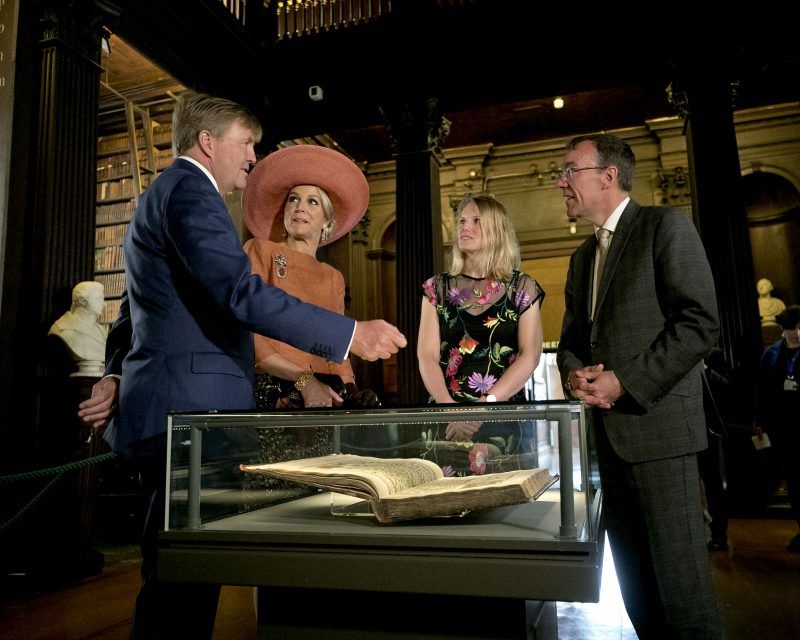King and Queen of the Netherlands visit Trinity to view precious Fagel collection
Posted on: 13 June 2019
The King and Queen of the Netherlands visited Trinity today as part of their State visit to Ireland.
During their visit, the King and Queen visited Trinity’s Long Room situated in the College’s 18th century Old Library building which is home to precious research collections and manuscripts, most famous of which is the Book of Kells.
The ninth century gospel manuscript, written and illustrated by Columban monks, is famous throughout the world for its beautifully intricate decoration and is representative of Ireland as a seat of art and learning.
Welcoming King Willem-Alexander and Queen Maxima, Trinity’s Deputy President, Professor Chris Morash, said:
We are delighted to welcome the Dutch King and Queen to Trinity College Dublin, Ireland’s oldest university, which has produced some of the world’s great minds across the sciences and the humanities, including two Nobel Laureates, Samuel Beckett in literature and Ernest Walton in science. We are honoured by this visit which strengthens our relations with the Netherlands.

King Willem-Alexander and Queen Maxima were also given a special viewing of the Dutch ‘Fagel collection’.
This 18th century collection was built up over five generations of the Fagel family, many of whom held high public office in the Netherlands. It is enormously rich in French, Dutch and English works on politics, religion, economics, sciences, natural history and travel, and reflects the professional concerns of the family.
The collection came to Trinity in 1802 when Hendrik Fagel the Younger, ‘Griffier’ or Chief Minister to the States General of the Netherlands, was stranded in England while French revolutionary forces invaded his country. Having shipped the collection to London, he was eventually forced to sell it. The collection was subsequently purchased and gifted to Trinity.

Recent work undertaken on the collection has revealed that upwards of 10% of the titles in the collection are the only surviving copies and some of the maps are the earliest known maps of regions of the world.
Through Trinity’s philanthropic campaign, Inspiring Generations, the Library is currently fundraising to make the collection available to a global audience of researchers in the Virtual Trinity Library. It also aims to digitally ‘reunite’ the collection with related library, archive, museum and private collections around the world, using enhanced technologies in collaboration with the National Library of the Netherlands, the Koninklijke Bibliotheek, and with colleagues at the University of St Andrews.
Commenting on the future plans for the Fagel Collection, Head of Research Collections at the Library of Trinity College, Laura Shanahan, said:
The Fagel Collection came to Trinity as a philanthropic gift, and now, as part of the University’s philanthropic campaign – Inspiring Generations – the Library is working closely with the Trinity Long Room Hub Arts and Humanities Research Institute, and with European partners, like the National Library of the Netherlands, to secure funding in order to provide global access to this precious collection for a new generation of scholars, citizen scientists, and the wider public.
During their visit, the Royal couple were shown a selection of items from the Fagel collection by Alex Alsemgeest, book historian and researcher for the national bibliography of the Koninklijke Bibliotheek, who is part of the research collaboration. They included:
- Colour plate books, including: the oldest printed book in the Fagel Library, Plutarch’s Vitae virorum illustrium (‘Parallel Lives’), Vol.1. (Venice, 1478); and Jan Commelin’s Horti medici Amstelodamensis (Amsterdam, 1697). Commelin was one of the founders of Amsterdam’s botanic garden
- A book once belonging to Constantijn Huygens (Dutch Golden Age poet and composer, and secretary to two Princes): Pieter Post: Begraeffenisse van syne hoogheyt Frederick Henrick (Amsterdam, 1651)
- The only recorded copy of the Declaration of the Dutch Independence printed in Arnhem (1581)
- Two manuscripts, including: Simon van der Stel’s Diary of his journey to Namaqualand (1685), which includes 72 coloured drawings which may be by Hendrik Claudius of Breslau; and the Catalogue of tulips from the infamous Alkmaar auction of 1637, which saw the economic downturn following ‘tulipmania’
- A mid-18th century plan map of the Hague, by Daniel Langeweg (1747)
